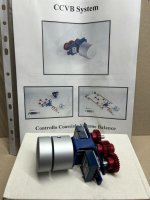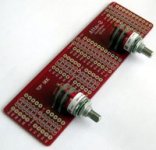I believe there is some graphics posted back, even for that
you mean - everything per schematic, just without autoformer, so plain buffer preamp?
if yes, gain jumper to 6db, and solder short wire bridge between "5j" and "C8" transformer pads
you mean - everything per schematic, just without autoformer, so plain buffer preamp?
if yes, gain jumper to 6db, and solder short wire bridge between "5j" and "C8" transformer pads
PM sent to you.I have some that I can send. I'll pm you. These are left unused as I am building two balanced versions.
Thanks. nash
Needed parts will arrive shortly. I just couldn't help myself by ordering yet another stacked mono volume control, complete with gearing to use for volume and balance. This should have caught on long ago.
Had an interesting idea lately about using this stacked mechanical configuration. Yes, it is intended to be used a mono operation per each knob. That is what gives you the ability to have the balance of channels in an easy form. The 'what if' bug hit me and it is possible to abandon this thinking for the mono pots, and instead use the stacked figuration to control 'coarse/fine' stereo adjustment instead. One knob has coarse volume and the other a fine volume in smaller steps. There is the key word> steps, as in Stepped attenuators. Yes, yes this will involve more mechanical work and a different wiring of the stepped attenuators. Go to the Glassware Audio site and look at John's ingenious designs in different sorts of volume control situations.
Right now this is just a thought that started from wanting to use stepped attenuators instead of potentiometers. Nothing wrong there except that stepped units are fatter than the needed pots for this build. The answer then is to use rod extensions and reverse the resistor sequence in order to keep the audio taper. It is reversed since the physical position demanded for this design literally reverses the pots position, making the resistor arrangement necessary.
Photos to come to help explain when parts arrive. It twists my mind a little boys.
Just trying to be more clear about this little venture. The first photo is the mechanical gear setup for separate mono controls. The second shot is from Glassware Audio where each switch is used for either the purpose of coarse or fine adjustment. Yes, I know this could get tricky.
Attachments
Soldering Lt 3042 MSOP-10 with a regular iron is not easy😅 It does put out the requested 5V though!
You would think a LSK170 should be a breeze, no?
I managed to this as well. I was able to finally offset to 0.00mv

Next step is to connect it to the dac's output and take my time testing the buffer with and without iron🙂
During my rearrangement of my HiFi system to allow for a TT I switched my SE IP from 6 dB to 12 dB gain to hear how it sounds compared to 6 dB.
After listening a bit I feel confident that this it the correct setting together with Lazy Singing Bush source followers.
The very subjective listening impression is that sound is more dynamic, slightly warmer and what I don't understand is that bas response seems more "vibrating" and deeper <-- I know this is just "the brain".
So, my BAL IP project (BAL in, SE out) will probably not be for the Lazy Singing Bush but for other power amps that have some voltage gain like M2X, VFET Kit amp etc.
After listening a bit I feel confident that this it the correct setting together with Lazy Singing Bush source followers.
The very subjective listening impression is that sound is more dynamic, slightly warmer and what I don't understand is that bas response seems more "vibrating" and deeper <-- I know this is just "the brain".
So, my BAL IP project (BAL in, SE out) will probably not be for the Lazy Singing Bush but for other power amps that have some voltage gain like M2X, VFET Kit amp etc.
You can play around with the Voltage too. THD and H2 increase slightly. My present preference in my system is 12.5V. Heatsinks on devices needed.slightly warmer
nash
I spend some time ensuring rather exact -+ 15 VDC 🙂
Technical.......when driving a source follower I need as much "headroom" as possible so I would think I should maybe increase it a bit.
Could be interesting to look at a distortion analyzer when playing around with the rails.
Also interesting how much difference there is in H2 in 6 dB vs. 12 dB setting. Or H2 relative to H3. Probably in the originalt thread there are some measurements.
Technical.......when driving a source follower I need as much "headroom" as possible so I would think I should maybe increase it a bit.
Could be interesting to look at a distortion analyzer when playing around with the rails.
Also interesting how much difference there is in H2 in 6 dB vs. 12 dB setting. Or H2 relative to H3. Probably in the originalt thread there are some measurements.
nope
ZM didn't bother measuring plain vanilla JFet buffer driving autoformer
Pa is certainly having his own gigglywigglies for his B1T but I'm not sure he's going to dig them
ZM didn't bother measuring plain vanilla JFet buffer driving autoformer
Pa is certainly having his own gigglywigglies for his B1T but I'm not sure he's going to dig them
Ok, but sound is very nice also in 12 dB setting which is what I prefer right now.......and it of course makes sense when driving a follower.
Can you hear the difference, or is it measured?Also interesting how much difference there is in H2 in 6 dB vs. 12 dB setting. Or H2 relative to H3.
I also prefer running the IP on 12dB gain in my system, with a TDA8932 amp and full range speakers. Just a better balance, but I cannot say for sure that there is a difference in sound between 6dB and 12dB gain.
It is pure subjective listening (no measurements).
Output from DAC is less. I have DAC in preamp mode and IP is just a fixed 6 or 12 dB gain (no pot).
I don't know how good the analog stage in DAC is. Maybe it delivers a better signal if not cranked between 80-100% of max. output which was the case in 6 dB setting. There are many "variables". In 12 dB setting I get more IP and less DAC 🙂
In preamp mode DAC can deliver higher output compared to fixed (standard line signal) mode.
Output from DAC is less. I have DAC in preamp mode and IP is just a fixed 6 or 12 dB gain (no pot).
I don't know how good the analog stage in DAC is. Maybe it delivers a better signal if not cranked between 80-100% of max. output which was the case in 6 dB setting. There are many "variables". In 12 dB setting I get more IP and less DAC 🙂
In preamp mode DAC can deliver higher output compared to fixed (standard line signal) mode.
^ So, how do you know that the harmonics have shifted / changed?
Are you saying that it would be interesting to know these differences or that you observed these differences?Also interesting how much difference there is in H2 in 6 dB vs. 12 dB setting. Or H2 relative to H3. Probably in the originalt thread there are some measurements.
It may not have shifted / changed it is pure imagination.
The subjective listening test without any technical evidence was that sound was slightly "warmer" and more dynamic and also a more "vibrant" bas response.
The subjective listening test without any technical evidence was that sound was slightly "warmer" and more dynamic and also a more "vibrant" bas response.
I found pretty much the same. 🙂 I was slightly overdamped at 14R, pretty good and probably just fine was 40R. 17.2 looked ideal to me. I snagged 15 from the parts box and stuck it in instead of the pot. Looked solid. Thanks!FWIW, my Quasimodo snubber resistor measurement for the AS-0218 was 20.7R (using standard .15uF and .01uF Cs and Cx).
Note - I ran mine with the primaries shorted and like using two bridges (one secondary measured and one shorted) vs. the CT configuration. When I ran the CT configuration, it was pretty much the same though.
I transpose #'s / letters all the time... so it took me 1/2 a step to equate Cx (Mark's article) => CS (on Iron Pre Schematic) and Cs to CS1. If I got that right... 🙂
- Home
- Amplifiers
- Pass Labs
- Iron Pre Essentials Kits For The DIYA Store - Register Your Interest


